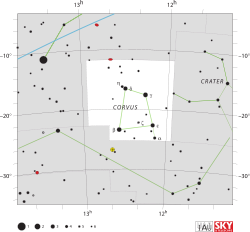Delta Corvi
| Observation data Epoch J2000 Equinox J2000 | |
|---|---|
| Constellation | Corvus |
| Right ascension | 12h 29m 51.85517s[1] |
| Declination | −16° 30′ 55.5525″[1] |
| Apparent magnitude (V) | +2.962[2] |
| Characteristics | |
| Spectral type | A0 IV(n) kB9[3] |
| U−B color index | −0.050[2] |
| B−V color index | −0.045[2] |
| Astrometry | |
| Radial velocity (Rv) | +9[4] km/s |
| Proper motion (μ) | RA: −210.49[1] mas/yr Dec.: −138.74[1] mas/yr |
| Parallax (π) | 37.55 ± 0.16 mas[1] |
| Distance | 86.9 ± 0.4 ly (26.6 ± 0.1 pc) |
| Absolute magnitude (MV) | +0.2[5] |
| Details | |
| Mass | 2.74+0.07 −0.06[6] M☉ |
| Luminosity | 69.0+9.7 −8.9[6] L☉ |
| Surface gravity (log g) | 4.06±0.05[6] cgs |
| Temperature | 10400[6] K |
| Rotational velocity (v sin i) | 236[7] km/s |
| Age | 260+14 −24×106 or 3.2+0.1 −0.1×106[6] years |
| Other designations | |
Delta Corvi (δ Crv, δ Corvi) is a star in the southern constellation of Corvus. It has the traditional name Algorab (from Arabic الغراب al-ghuraab, meaning "the crow"). This is a third magnitude star at a distance of 86.9 light-years (26.6 parsecs) from Earth. In 1823, it was found to be a wide double star by British astronomers James South and John Herschel. Since that time, the position of the two stars with respect to each other has not changed.[9]
This star has more than 2.7 times the mass of the Sun, which is causing it to radiate a much higher energy output—roughly 69 times the Sun's luminosity. The effective temperature of the outer atmosphere is 10400 K,[6] giving it the white hue of an A-type star.[10] The spectrum matches a stellar classification of A0 IV(n) kB9.[3] However it is more luminous—65-70 times that of the Sun—than it would be if it were on the main sequence. Hence it is either a subgiant star around 260 million years old that has nearly exhausted the supply of hydrogen at its core and is in the process of evolving away from the main sequence of stars like the Sun, or a pre main sequence star around 3.2 million years old that has not completely condensed and settled on the main sequence.[6]
A 2006 study found that Algorab displayed no excess infrared emission that would otherwise suggest the presence of circumstellar matter,[11] however warm interstellar dust was detected in a 2014 study.[12] It has a magnitude 9.3 companion, HR 4757 B, with a classification of K2Ve at an angular separation of 24.2 arcseconds along a position angle of 214°.[9][13] Although the two stars share a common proper motion,[13] the significant differences in their estimated ages suggests that they may not be physically connected.[6]
In Chinese, 軫宿 (Zhěn Sù), meaning Chariot (asterism), refers to an asterism consisting of δ Corvi, γ Corvi, ε Corvi and β Corvi.[14] Consequently, δ Corvi itself is known as 軫宿三 (Zhěn Sù sān, Template:Lang-en.).[15]
USS Algorab (AKA-8) is a United States navy ship.
References
- ^ a b c d e van Leeuwen, F. (November 2007), "Validation of the new Hipparcos reduction", Astronomy and Astrophysics, 474 (2): 653–664, arXiv:0708.1752, Bibcode:2007A&A...474..653V, doi:10.1051/0004-6361:20078357
- ^ a b c Gutierrez-Moreno, Adelina; et al. (1966), A System of photometric standards, vol. 1, Publicaciones Universidad de Chile, Department de Astronomy, pp. 1–17, Bibcode:1966PDAUC...1....1G
- ^ a b Gray, R. O.; et al. (July 2006), "Contributions to the Nearby Stars (NStars) Project: Spectroscopy of Stars Earlier than M0 within 40 parsecs: The Northern Sample I", The Astronomical Journal, 132 (1): 161–170, arXiv:astro-ph/0603770, Bibcode:2006AJ....132..161G, doi:10.1086/504637
- ^ Wilson, Ralph Elmer (1953). General Catalogue of Stellar Radial Velocities. Washington: Carnegie Institution of Washington. Bibcode:1953QB901.W495.....
- ^ Blondel, P. F. C.; et al. (September 2006), "Modeling of PMS Ae/Fe stars using UV spectra", Astronomy and Astrophysics, 456 (3): 1045–1068, Bibcode:2006A&A...456.1045B, doi:10.1051/0004-6361:20040269
- ^ a b c d e f g h Montesinos, B.; et al. (March 2009), "Parameters of Herbig Ae/Be and Vega-type stars", Astronomy and Astrophysics, 495 (3): 901–917, arXiv:0811.3557, Bibcode:2009A&A...495..901M, doi:10.1051/0004-6361:200810623
- ^ Royer, F.; Zorec, J.; Gómez, A. E. (February 2007), "Rotational velocities of A-type stars. III. Velocity distributions", Astronomy and Astrophysics, 463 (2): 671–682, arXiv:astro-ph/0610785, Bibcode:2007A&A...463..671R, doi:10.1051/0004-6361:20065224
- ^ "del Crv -- Variable Star", SIMBAD, Centre de Données astronomiques de Strasbourg, retrieved 2012-01-30
- ^ a b Garfinkle, Robert A. (1997), Star-Hopping: Your Visa to Viewing the Universe, Cambridge University Press, p. 109, ISBN 0-521-59889-3
- ^ "The Colour of Stars", Australia Telescope, Outreach and Education, Commonwealth Scientific and Industrial Research Organisation, December 21, 2004, retrieved 2012-01-16
- ^ Su, K. Y. L.; et al. (December 2006), "Debris Disk Evolution around A Stars", The Astrophysical Journal, 653 (1): 675–689, arXiv:astro-ph/0608563, Bibcode:2006ApJ...653..675S, doi:10.1086/508649
- ^ Ertel, S.; Absil, O.; Defrère, D.; Le Bouquin, J.-B.; Augereau, J.-C.; Marion, L.; Blind, N.; Bonsor, A.; Bryden, G.; Lebreton, J.; Milli, J. (2014). "A near-infrared interferometric survey of debris-disk stars. IV. An unbiased sample of 92 southern stars observed in H band with VLTI/PIONIER". Astronomy & Astrophysics. 570: 20. arXiv:1409.6143. Bibcode:2014A&A...570A.128E. doi:10.1051/0004-6361/201424438. A128.
{{cite journal}}: CS1 maint: multiple names: authors list (link) - ^ a b Eggleton, P. P.; Tokovinin, A. A. (September 2008), "A catalogue of multiplicity among bright stellar systems", Monthly Notices of the Royal Astronomical Society, 389 (2): 869–879, arXiv:0806.2878, Bibcode:2008MNRAS.389..869E, doi:10.1111/j.1365-2966.2008.13596.x
- ^ Template:Zh icon 中國星座神話, written by 陳久金. Published by 台灣書房出版有限公司, 2005, ISBN 978-986-7332-25-7.
- ^ Template:Zh icon 香港太空館 - 研究資源 - 亮星中英對照表, Hong Kong Space Museum. Accessed on line November 23, 2010.

